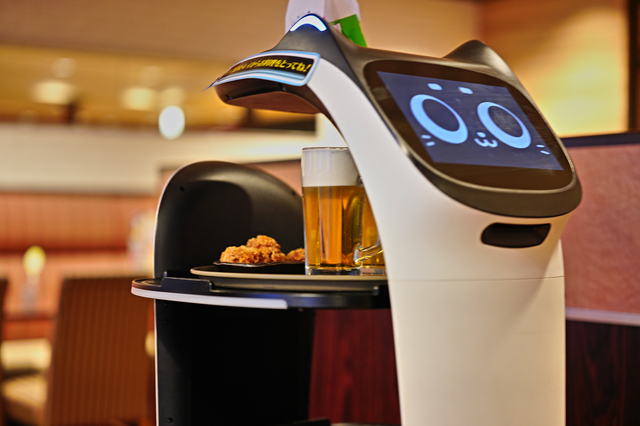Reading Yawarakai kojinshugi no tanjo after working part-time in a logistics warehouse

[…] now cat-shaped robots are working in family restaurants. Is this a “post-post-industrial society”? Not only consumption, but also human interaction has been lost in all areas of society, such as production and distribution. In this sense, individualization has progressed endlessly.
Photo: Lupinus Images / PIXTA
A cat-shaped robot, or a cat-imaged robot. It’s the one that recently started serving food in family restaurants. It has round eyes. If you stroke its head, it will happily close its eyes and say, “That tickles, meow.” It also says, “Thank you for your order, meow.” Just by walking by a table, children get excited and say, “How cute!” Apparently her official name is BellaBot.
But don’t let its cuteness fool you. If you think about it rationally, it’s a robot carrying food made in a factory. Customers order on a tablet and pay with an automatic change machine. Written like that, doesn’t it seem a bit bland?
Yamazaki Masakazu (1934–2020), playwright and critic, once said this about family restaurants: “The products offered are essentially factory-produced frozen foods, and what customers receive in the store is nothing but the atmosphere at the table and the performance of the waiter, in other words, the ‘illusion’ of hospitality” (Yawarakai kojinshugi no tanjo [The birth of soft individualism: The aesthetics of a consumer society]).
In other words, according to Yamazaki, family restaurants needed “direct performances of hospitality by people” to remove the “image of mechanical media such as refrigerated trucks and refrigerators.” And customers flocked to them in search of such hospitality.
But what we have in family restaurants today is not serving, but feeding. There is no performance of hospitality. Instead, we have the “cuteness” of cat-shaped robots. And we are fools, easily fooled by cuteness. Even the barricades at construction sites have turned into cute characters these days.

YAMAZAKI Masakazu, Ph.D.
Playwright and Critic
Born 1934 in Kyoto Prefecture. He completed the doctoral course at the Kyoto University Graduate School, specializing in aesthetics. He served as a professor at Kansai University and Osaka University, and was the President of the University of East Asia. In 2006 he was made a Person of Cultural Merit and awarded the Order of Culture in 2018. His best-known plays are Zeami, Oedipus Shoten (The ascension of Oedipus) and The man who captured Eichmann—words. His many written works include Gekiteki naru nihonjin (Japanese, as Theoretical People), Yawarakai kojinshugi no tanjo (Birth of soft individualism), Shako suru ningen (Homo Sociabilis: Sociability and Human Beings), Soshoku to dezain (Decoration and design) and Rizumu no tetsugaku noto (Notes on the philosophy of rhythm).
Photo: ©2013 H. Endo
Yamazaki Masakazu’s Yawarakai kojinshugi no tanjo was published in 1984. It was often mentioned in the discussion magazine Asteion at the time of its release. The nation lost its former presence, and individuals were liberated from groups such as corporations and families. As the “individualization” of individuals progressed in this way, people gathered in cultural clubs, civic lectures, and volunteer work to pursue hobbies and culture. What is needed for individuals who participate in many small face-to-face gatherings is not a strong sense of self that can be sincerely committed to one group, but a flexible sense of self that can consciously play different roles in different groups.
Yamazaki’s argument was based on an analysis of consumer society. It was a “post-industrial society” that shifted the emphasis from material production to information and services (Daniel Bell [1919–2011], The Coming of Post-Industrial Society, 1974). In service industries where people interact with other people, acting for the sake of socializing is necessary. Enjoying interactions between people—socializing—is nothing but consuming time and events themselves. The new social model of time consumption goes beyond the mass production and mass consumption society in which things have been efficiently produced and “consumed.” Therefore, the “birth of soft individualism” is a “civilization-historical shift.”
But now cat-shaped robots are working in family restaurants. Is this a “post-post-industrial society”? Not only consumption, but also human interaction has been lost in all areas of society, such as production and distribution. In this sense, individualization has progressed endlessly. However, I cannot help but think that soft individualism has not been born.
I work part-time as a picker in a distribution warehouse. I scan the bar code on the packing slip with my handheld terminal. The instruction “Product A1345, quantity 3” appears on the display, so I pick the products and pack them into cartons. Robots are already in use in large warehouses, so this job will be eliminated in the near future. However, it seems that it is still cheaper to overwork a peasant [me] for the minimum wage of 900 yen.
A week after I started working there, I noticed something. There was no conversation. There were dozens of people working in the same warehouse. But no one was talking. All the work was done by one person. There was no need to communicate. Instructions are given via handheld terminals, and if I were about to make a mistake, the handheld terminal would warn me.
This part-time job was very comfortable for me. I had previously worked as a picker in a vegetable shipping area. However, it wasn’t digitized and I was given strict instructions by an old lady who was in charge of training. I was often reprimanded for being careless. For example, I once shipped Japanese parsley that had melted into a muddy mess, and I was yelled at, “Even kindergarteners wouldn’t make a mistake like that!”
If there is no communication, there will be no sexual harassment or power harassment. You will be free of annoying work relationships. Of course, there are some jobs that require human interaction, but by using technology, communication is suppressed as much as possible. You are always being watched. If you know that a log will be left as a record, you will not say unnecessary things. With harassment now under the microscope, human communication is a risk for companies.
Human interaction is painful. I’d rather be alone as much as possible… The reason I was able to get a part-time job in a logistics warehouse is that a growing number of consumption patterns reflect this sentiment. I order products online and have them delivered to my door the next day. It’s very convenient. Especially since the COVID-19 pandemic has meant that face-to-face communication has been restricted to reduce the risk of infection. Scenes like this are becoming commonplace.
But in exchange for the comfort of being alone, I have lost something. Sometimes when I work part-time, I get scared. If this pile of boxes collapses and crushes me, no one will notice. Without communication, there would be no harassment, but there would be no way to get closer. People would not be able to help each other. There is a saying, “divide and conquer,” but to eliminate the risk of workers uniting, it is better to have no communication.
The term “xxx gacha” has become more common. For example, there is the term “Oya-gacha”[1] (literally, “parental lottery”), which likens the parents you were born to to a prize lottery. Human life is determined by luck. It is interesting to note that Yamazaki points out that such issues of “chance” and “probability” arise because of the individualization of individuals (Fukushima Ryota [literary critic], in his commentary on the new expanded paperback edition of Yawarakai kojinshugi no tanjo, probably refers to Yamazaki’s point in relation to Azuma Hiroki’s [critic and philosopher] research on postmodern thought and the information society).
In other words, human misfortune becomes individualized. As collective disasters that affect entire groups are addressed as universal problems, issues of chance such as “why did I survive while that person did not?” emerge. Such personalized misfortunes can appear as if they are the result of “demonic arbitrary selection,” making one acutely aware of the “absurdity of fate.” Moreover, “selective, random catastrophes” prevent people from sharing their misfortune with others and drive them into “grave loneliness.”
In my view, personalized misfortune has much to do with the recent popularity of identity politics. Many people cannot bear the randomness or meaninglessness of their own misfortune. So by collectivizing it, they give it meaning by saying, “It’s not my misfortune, it’s our misfortune.” In other words, my misfortune is our misfortune, which will come to me by fate as long as I have a specific identity.
Yamazaki once pointed out that “socializing” is possible even on the Internet (Shako suru Ningen: Homo soshiabilisu [Homo Sociabilis: Sociability and Human Beings]). However, the Internet has become a place where different “we’s” reject each other. The Internet is a place where only people with the same values gather. We console each other for our misfortunes and collectivize as “we.”
This is how identity politics, which could be called rigid collectivism, became popular. By assuming that the statistically represented “we” is myself. By being so sincerely committed to a group, the individual dissolves into the group. However, this kind of collectivism does not contradict the further individualization of the individual and the comfort of being alone. For what you encounter in the “we” is nothing but another “I.” A space filled with countless “I’s” is very comfortable and heals acute loneliness.
By the way, seeing the cat-shaped robot reminds me of the popular manga Chiikawa (Nanka chiisakute kawaii yatsu [Something Small and Cute]), which is serialized on Twitter (now X). Small and cute characters like cats and rabbits live in a world where civilization seems to have collapsed, weeding and defeating monsters.
The anthropomorphic animals do not give the impression of gender, such as male or female. They look like small children, but they are carefully designed not to arouse sexual excitement. Their soft, round form does not hurt anyone and does not give the impression of violence. The figures are brave, pure and fragile, appealing to the paternal instinct to care for them.
Not only are there no elements to be angry about in these characters, but they are ideal self-portraits of us unfortunate people who are sensitive to representation and easily hurt. They take qualifying exams, eat ramen, and drink alcohol, just like us.
These cute characters live in a dark world. They are controlled by armored humans, attacked by monsters, turned to stone, and some even turn into monsters themselves.
However, the cruel world view is not clearly shown, but only hinted at. Therefore, the reader must piece together the numerous clues to solve the mystery of the work’s world. However, the method of analysis is very similar to that of conspiracy theorists such as QAnon.
A world where “cute” has replaced socializing. The spread of “cuteness” serves to mask a cold and lonely controlled society.
Just like the spiky protrusions in parks that are meant to exclude homeless people, they become works of art to show that there is no intention to exclude them. But when you try to expose the cruelty, it somehow becomes a conspiracy theory. Such a cute world.
It would be untrue to say that the “socializing” Yamazaki emphasized doesn’t evoke a sense of upper-class salon culture, but it seems that we are gradually forgetting how to socialize. If socializing has disappeared from the business world, we need to find a new form of it. Knowledge comes from such interactions.
[1] Japanese term referring to the idea that a person’s life prospects are significantly influenced by the parents they are born to, much like a random draw in a gacha game.
Translated from “Tokushu ‘Genron arina’ toshiteno kokoromi sokan 100-go wo mukaete III warewareno ronjitekitakoto: Butsuryu soko no baito no atoni Yawarakai kojinshugi no tanjo wo yomu (Special feature: Attempts to be an ‘arena for speech’ — Celebrating the 100th issue III. What we have discussed: Reading Yawarakai Kojinshugi no Tanjo after working part-time in a logistics warehouse),” Asteion, Vol. 100 2024, pp. 207-211. (Courtesy of CCC Media House Co., Ltd.)[August 2024]
Keywords
- Watano Keita
- Yamazaki Masakazu
- Yawarakai kojinshugi no tanjo
- birth of soft individualism
- individualization
- cat-shaped robot
- Bellabot
- family restaurant
- hospitality
- consumer society
- consumption
- post-industrial society
- post post-industrial society
- Daniel Bell
- socializing
- human interaction
- communication
- harrassment
- risk
- identity politics
- collectivism
- loneliness
- Chiikawa
- cute
- cuteness
- QAnon
 WATANO Keita
WATANO Keita



